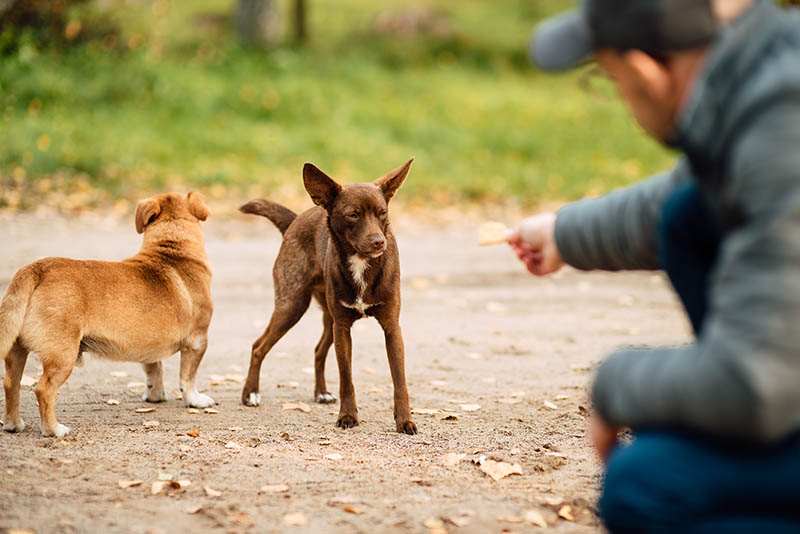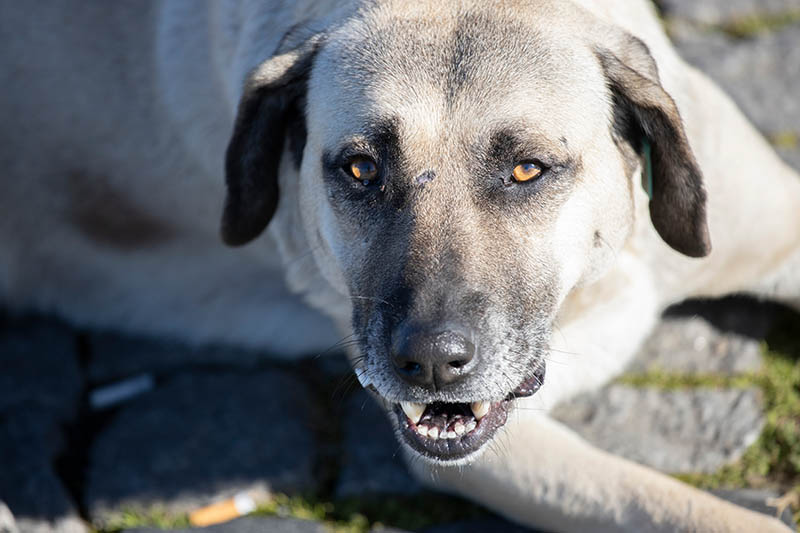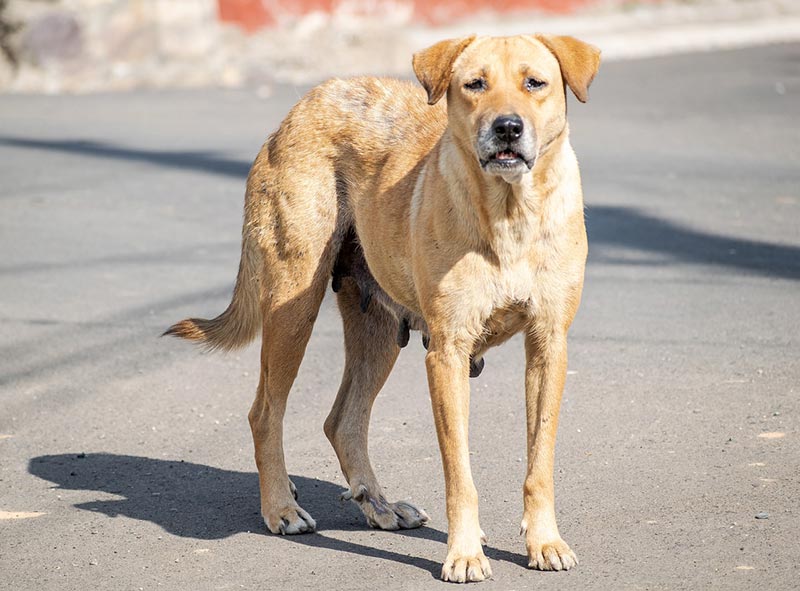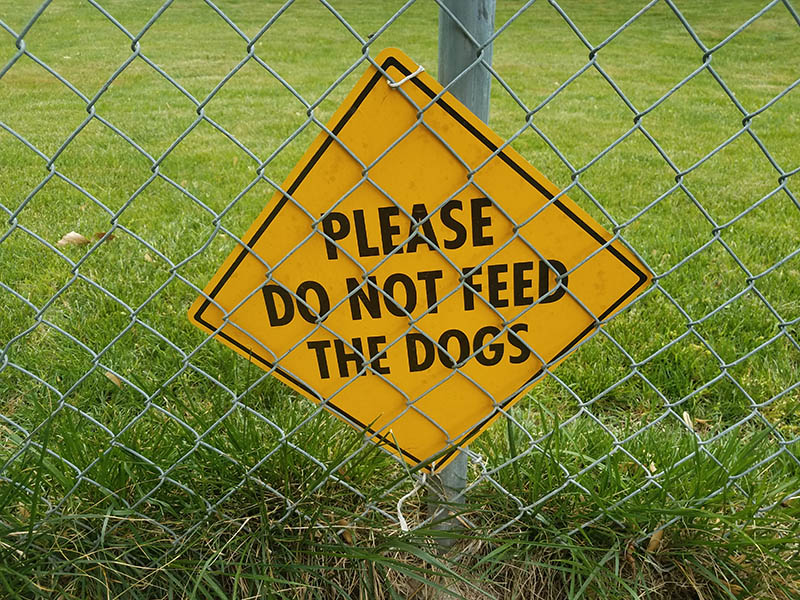Can You Feed Stray Dogs? Our Vet Explains the Risks
By Dr. Luqman Javed, DVM (Vet)
Updated on

Stray dogs are a common sight in some places, and they can tug on people’s heartstrings. Stray dogs often look leaner and dirtier than companion dogs. This can cause people to think that they just need some food to help them get by. Anyone technically can feed stray dogs, but the real question is should you feed them?
Generally speaking, if you’re intending to neuter, vaccinate, and/or adopt a stray dog, then it’s acceptable to feed them, with the permission of local authorities. However, if you’re only feeding them with no such intentions, then feeding a stray is considered counterproductive for animal welfare.
Feeding stray dogs might seem like a helpful and ethical thing to do, but it also has a slew of problems if your goal is to just feed them with no plans of an eventual rescue. It can be dangerous, it can be harmful to the dogs, and it can cause conflict between neighbors. If you have the urge to feed a local stray dog, ensure you fully understand the implications of doing so. In this article, we’ll explore the reasons why it’s risky to feed a stray dog, and instances where it is acceptable to do so.
The Plight of Stray Dogs
It goes without saying that stray dogs live a relatively rough life. They’re constantly dealing with circumstances beyond their control: unexpected weather, other predators, rival dogs, humans who don’t appreciate their presence, automobiles, hunger, diseases, and no medical care whenever they need it. Seeing an animal going through all these difficulties is indeed very gut wrenching. It’s only natural to want to help them; therefore, you shouldn’t feel bad for wanting to do so.
However, it’s also important to remember that, inherently, strays are a man-made issue; there are no strays in the wild. The reason strays exist is because they were never offered a home but were offered enough resources (in terms of table scraps, trash, etc.) to want to stay in the proximity of humans.
Dogs are often driven by instincts, regardless of whether they are strays or pets. The issue with feeding strays is that they will instinctively try to reproduce when they feel like they have enough resources to do so. This is a primitive instinct and one that cannot be suppressed in sexually mature, intact animals.
Consequently, feeding stray dogs leads to the birth of more stray puppies, and the cycle continues, where animals that should be pets are unfortunately living a tough life on their own. For these reasons, most pet welfare organizations advise against feeding strays, as the result is usually a colony of dogs all struggling for survival.

Feeding With Purpose
Feeding a stray animal with intentions to offer them a better life is generally considered acceptable. An approach some cities have adopted is befriending the strays of the area that don’t seem to bother or attack humans, capturing them, having them vaccinated and neutered, and releasing them back to where they were originally found. This is often referred to as a capture-neuter-release or trap-neuter-release program.
The intention of such a program is to create a buffer of healthy, vaccinated, and friendly dogs that won’t propagate but will prevent other stray animals (that might be potentially dangerous) from occupying the area if they were completely removed. Often, these programs are advertised, and most cities have their own approach to such endeavors. The animals involved in the program are often given a mark that lets others know they’ve been neutered (usually a notch on an ear).
With an estimated 200 million stray dogs around the world and only one country (the Netherlands) having the honor of having no stray dogs, a capture-neuter-release program remains the gold standard for handling stray animals.
If you’re interested in adopting a stray dog and bringing them indoors over time, or having someone else adopt them, then it is considered acceptable to feed them because your intentions are to help fix the problem and not propagate it. However, as we’ll explain shortly, please ensure it is both safe and legal to do so where you reside.
The 4 Risks of Feeding Stray Dogs
Feeding strays is not without its risks or issues.
1. Stray Dogs Can Be Unpredictable
One of the biggest problems with feeding stray dogs is that they can be unpredictable. Since the dogs live in the wild, they do not have the same habits and manners as companion dogs. Stray dogs can bite people, attack children, fight with other dogs, and become territorial over spaces where you are feeding them. In the wild, these are natural behaviors, but they are not safe behaviors for people. Feeding stray dogs can open you up to these kinds of dangerous behaviors by strange dogs.

2. It Affects the Whole Neighborhood
Feeding stray dogs can affect the whole neighborhood. You might think that you are doing a good deed, but your neighbors might not agree. Since stray dogs can be dangerous and unpredictable, few people want them around in residential areas. Feeding stray dogs will cause them to stick around, and it might even attract larger numbers of strays to congregate in the area. That can quickly become a point of conflict between you and other people in the area. Some people don’t like pet dogs, much less stray dogs.
3. Stray Dogs Can Carry Dangerous Diseases
Stray dogs can also carry diseases. Some of these diseases can be spread from the stray dog population to local residential dogs. If stray dogs have parasites or worms, they can be spread to pet dogs through their feces. The most concerning and dangerous disease that stray dogs could carry is rabies. According to the CDC, rabies kills an estimated 59,000 people per year worldwide and is not something to be trifled with.
Important: If you’re bitten by a stray dog, especially in an area that isn’t considered rabies-free, immediately wash the bite wound with soap and water for at least 20 minutes and then promptly seek medical care.

4. It Can Be Illegal
In many places, feeding wildlife is illegal. Generally, feeding wild animals on public lands is always illegal. If you are caught feeding stray dogs (or if your grumpy neighbors turn you in), you could face fines and receive warnings that will make the punishments stiffer if you continue. Many of the reasons for these laws are the same ones we have already listed here. Wildlife is unpredictable. Wildlife (including stray dogs) can carry diseases, they don’t always need human food, and they can become a nuisance.

What to Do if You Are Worried About a Stray Dog
If you are worried about a stray dog and want to help it, you can call your local animal shelter or animal control officer. You should only report stray dogs if they pose a danger to local people, are being a nuisance, or look emaciated or injured. The officers will be able to determine if the dog is missing or if it is a true stray.
Some strays will be spayed and neutered and relocated to a better location. Other strays will be given care and prepped for adoption if they are deemed safe for people to own. Most regular people need to be qualified to make these determinations on their own, and they should let local authorities deal with stray dogs to avoid any mishaps or problems.
Final Thoughts
Generally speaking, feeding stray dogs just to offer them sustenance is considered counterproductive for animal welfare. In circumstances where the intention is to rehome, adopt, or neuter the animal, feeding can be considered acceptable. However, such programs are usually organized by local authorities and not something you should attempt to do on your own, as approaching strays is not risk-free.
Relying on professionals is the best way to handle these stray animals. Feeding stray dogs might feel right and seem like a good idea at the moment, but experts agree that it is almost always the wrong decision if no consideration is given towards the animal’s future.
Featured Image Credit: matsiukpavel, Shutterstock












